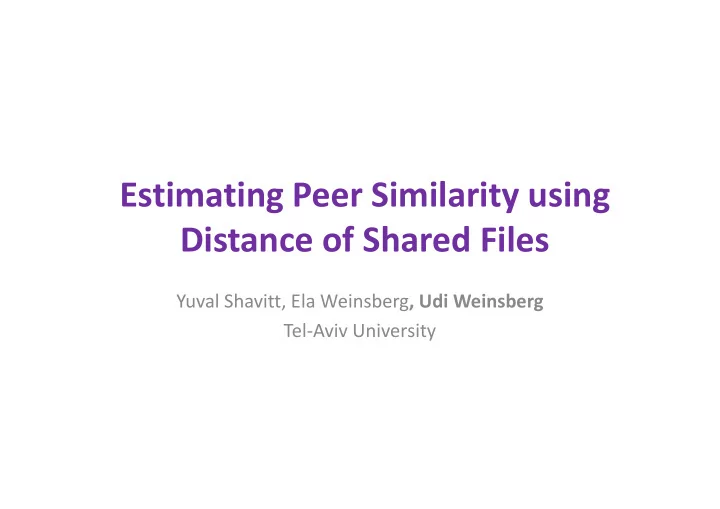

Estimating Peer Similarity using Distance of Shared Files Distance of Shared Files Yuval Shavitt, Ela Weinsberg , Udi Weinsberg Tel-Aviv University
Problem Setting � Peer-to-Peer (p2p) networks are used by millions for sharing content � Increasingly difficult to find useful content o Noise in user generated content (meta-data) Noise in user generated content (meta-data) o Extreme dimensions o Sparseness Udi Weinsberg, IPTPS, April 2010 2
Work Goal � Suggest a new metric for peer similarity o Overcome the sparseness problem � Improve ability to find content o Search algorithms Search algorithms • Similar peers are likely to hold relevant content o Collaborative filtering • Find “like-minded” peers Udi Weinsberg, IPTPS, April 2010 3
Key Concept � Build a file similarity graph o Use data about all shared files o Weights of edges = distance between files � Peer similarity is calculated using the distance � Peer similarity is calculated using the distance between their shared files o No need for overlapping content between peers Udi Weinsberg, IPTPS, April 2010 4
Dataset � Active crawl of Gnutella in 2007 � Crawled 1.2 million peers � Only 35% of songs contain meta-data � 530k distinct songs � 530k distinct songs o Identified using “title|artist” o Accounting for spelling mistakes with edit distance Udi Weinsberg, IPTPS, April 2010 5
Dataset Statistics � Using a sample of 100k peers (<10%) � Over 511k songs remain (96%) Power-law Power-law Popularity Popularity 98% of the peers 98% of the peers distribution share less than 50 songs Udi Weinsberg, IPTPS, April 2010 6
Sparseness Problem Peers with very Peers with very Median maximal Median maximal Median maximal few popular few popular overlap is 20% songs Udi Weinsberg, IPTPS, April 2010 7
File Similarity Graph � Files are vertices � Link weight is the number of peers sharing both � Normalize similarity with popularity: Power-law Power-law distribution, filter distribution, filter � Filter causes distortion o Keep only top 40% o And no less than 10 Udi Weinsberg, IPTPS, April 2010 8
Peer Similarity Estimation (1) � Create a bi-partite graph connecting the files of every two peers � Connect files in the two sides with links: o If exact same file – weight is 1 If exact same file – weight is 1 o Otherwise – use normalized similarity along the shortest path between the files Udi Weinsberg, IPTPS, April 2010 9
Distance Estimation …. 0.2 0.5 0.8 0.9 1 Udi Weinsberg, IPTPS, April 2010 10
Peer Similarity Estimation (2) � Run maximal weighted matching on the bi- partite o Find the “best” matching links between files o The matching M is the sum of links weight o The matching M is the sum of links weight � Peer similarity Udi Weinsberg, IPTPS, April 2010 11
Maximal Weighted Matching …. 0.2 0.5 Udi Weinsberg, IPTPS, April 2010 12
Distance Estimation Issues � File similarity graph can have connected components o Some distances are infinite � All pairs shortest paths can be costly � All pairs shortest paths can be costly o Reduce the size of the similarity graph o Limit the search depth Udi Weinsberg, IPTPS, April 2010 13
Reducing Similarity Graph Size � For each file, take only the top N nearest neighboring files � Distribution almost overlap for N≥10 Udi Weinsberg, IPTPS, April 2010 14
Limit Search Depth � Stop searching files once reached K times the distance of the first finding o Distance between files become asymmetric o Depends on the peer we start from o Depends on the peer we start from � For K ≥1.5 links removed are unlikely to be selected in the maximum matching o Asymmetric links are mostly low-similarity links o Hence will not be selected in the matching Udi Weinsberg, IPTPS, April 2010 15
Meta-data and Similarity � Similarity between peers i and j using artists � Normalized similarity matches meta-data Udi Weinsberg, IPTPS, April 2010 16
Geography and Similarity � Comparing the distance with similarity � No direct correlation! Udi Weinsberg, IPTPS, April 2010 17
Conclusions � A metric for similarity between peers � Evaluation using song files shared in Gnutella o Metric reflects the similarity of peer preferences in music in music � Geography is not necessarily a good indication for peer similarity! Udi Weinsberg, IPTPS, April 2010 18
Thank You! Thank You! Udi Weinsberg udiw@eng.tau.ac.il
Recommend
More recommend